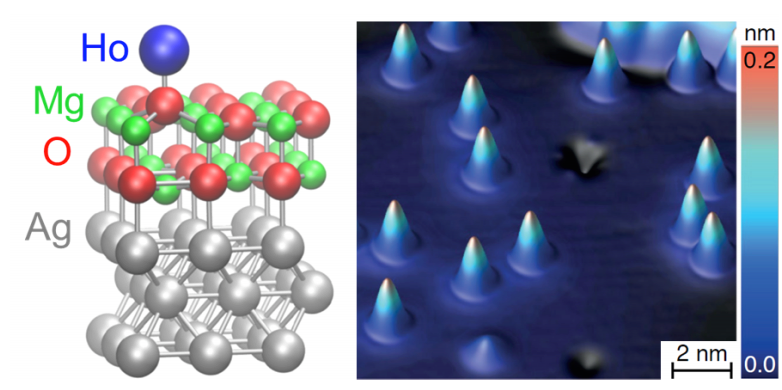Experimental realization of a single atom magnet

Magnets possess both strength and memory. These two properties make them useful for a broad variety of applications, which involve action at a distance or retention of magnetic information. The advent of modern rare-earth permanent magnets, with high remanent induction field and a magnetic energy product ten times greater than that of ferrites, made it possible to miniaturize electric motors for electromechanical actuators that are ubiquitous in industry, cars, and consumers’ electronic devices. Likewise, the miniaturization of magnetic bits makes it possible to store terabytes of information in magnetic hard drives that form the physical backbone of the IT cloud. Yet, the miniaturization of magnets, like that of transistors, cannot go on indefinitely. As a magnet is reduced in size, thermal fluctuations overcome the anisotropy barrier that keeps the magnetic axis stable, leading to the loss of permanent magnetization.
Scientists have been working for a long time to define and extend the size of permanent magnets down to the smallest possible limit. A recent study, carried out jointly by a team of researchers led by Pietro Gambardella (ETH Zürich) and Harald Brune (EPF Lausanne), may have reached the bottom of this quest. Their work, recently published in Science (external pageScience 352, 318 (2016)call_made), shows that single Holmium atoms deposited on a nonmagnetic MgO substrate display high coercivity and magnetic remanence up to a temperature of about 40 K, on a timescale of one hour. Although this may seem short compared to the magnetic retention time of macroscopic permanent magnets, such magnetic stability is unheard of for so tiny structures. For comparison, the magnetic relaxation time in the most stable single molecule magnets reported to date is of the order of 1 ms at the same temperature. Such a long-lived magnetic state enables to manipulate individual atomic spins using microwave fields and even dc electric currents, which is paramount for the development of model classical and quantum memory devices based on single atom magnet arrays.
The experiments were carried out at the Swiss Light Source and the European Synchrotron Radiation Facility, using x-rays to excite the Holmium electrons with element-specific sensitivity to provide information on its electronic configuration as well as magnetic spin and orbital moments. Ligand field multiplet calculations and density functional theory, performed by Sebastian Stepanow (ETH Zurich) and Željko Šljivančanin (Vinča Institute of Nuclear Sciences, Belgrade), were employed to interpret the data and provide additional information on the peculiar behavior of this system. This work is the consecration of a long effort that was started 15 years ago by Prof. Gambardella with pioneering experiments that first probed the magnetic ground state of monodispersed single atom arrays on surfaces.
As the researchers explain in their work, the key to magnetic stability in single atoms lies in the combined choice of the rare earth element and its supporting environment. The first, Holmium, provides an electronic ground state that has a robust magnetic moment and a well-defined magnetic axis, which is simultaneously protected from first order spin reversal processes when coupled to the crystal field of the substrate. The second, MgO, is a stiff insulating material that provides isolation from both electrons and thermal vibrations, which are responsible for inducing spin-flips and destroy magnetic remanence in small structures.
In the quest for small magnets, single atoms represent a complementary alternative to nanoparticles and single molecule magnets. The relative simplicity of the Ho/MgO system, based on common physical deposition methods, as well as its planar geometry open the possibility to probe and manipulate the atomic spin and its environment in a controlled way. Optimization of the substrate and of the experimental techniques required to access these tiny systems spearhead the realization of the new generation of nanomagnets.
Selected Publications
- Unconventional spin relaxation involving localized vibrational modes in Ho single-atom magnets, F. Donati, S. Rusponi, S. Stepanow, L. Persichetti, A. Singha, D. M. Juraschek, C. Wäckerlin, R. Baltic, M. Pivetta, K. Diller, C. Nistor, J. Dreiser, K. Kummer, E. Velez-Fort, N. A. Spaldin, H. Brune, and P. Gambardella, Phys. Rev. Lett. 124, 077204 (2020). Downloadarticle (PDF, 763 KB)vertical_align_bottom Downloadsupplementary (PDF, 4.2 MB)vertical_align_bottom
- Magnetic remanence in single atoms, F. Donati, S. Rusponi, S. Stepanow, C. Wäckerlin, A. Singha, L. Persichetti, R. Baltic, K. Diller, F. Patthey, E. Fernandes, J. Dreiser, Ž. Šljivančanin, K. Kummer, C. Nistor, P. Gambardella and H. Brune, Science, 352, 318 (2016). Downloadarticle (PDF, 912 KB)vertical_align_bottom Downloadsupplementary information (PDF, 3.3 MB)vertical_align_bottom
